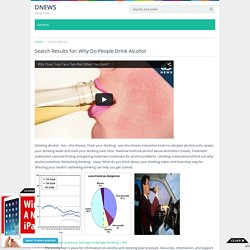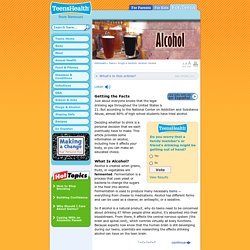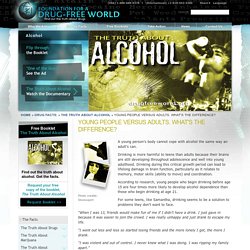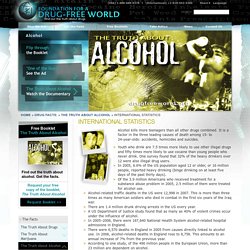

Alcohol Myth Busters on Pinterest. 0a572b282223177387eed856c6154e18.jpg (PNG Image, 403 × 403 pixels) 11d161b64e0c18d3ee368b8239a696e4.jpg (JPEG Image, 1275 × 1651 pixels) - Scaled (60%) Fact Sheets-Underage Drinking - Alcohol. Skip directly to A to Z list Skip directly to navigation Skip directly to page options Skip directly to site content CDC Alcohol Topics Get Email Updates To receive email updates about this page, enter your email address:

You searched for Why Do People Drink Alcohol - Dnews. Drinking alcohol - live - nhs choices, Track your drinking . use nhs choices interactive tools to calculate alcohol units, assess your drinking levels and track your drinking over time..

National institute alcohol abuse alcoholism (niaaa), Treatment publication carousel finding and getting treatment treatment for alcohol problems ; drinking made personal find out why; alcohol overdose. Rethinking drinking - niaaa, What do you think about your drinking habits and how they may be affecting your health? Rethinking drinking can help you get started.. Alcohol, peer pressure, teenage underage drinking | the The young teen's place for information on alcohol and resisting peer pressure. resources, information, and support on alcohol use and abuse among teenagers.. Why | why do? Infographic - Calories and alcohol. Infographic - How alcohol affects your appearance. How alcohol affects your appearance. Over indulging in alcohol can affect the way you look the next day – and in the future...

We'll say it fast to be kind, but alcohol is fattening. In fact, a pint of 4% beer or two double gin and tonics equals around one burger! You can use MyDrinkaware to find out how many calories there are in your favourite drinks and what the equivalent of those calories are in junk food. It will also help you keep track of what you're drinking over time and set yourself goals for cutting back so you're drinking within the government's lower risk guidelines. Alcohol Education Trust.
Binge Drinking. Listen Risks of Binge Drinking Many people don't think about the negative side of drinking.

Although they think about the possibility of getting drunk, they may not give much consideration to being hung-over or throwing up. Alcohol. Listen How Can I Avoid Drinking?

If all your friends drink and you don't want to, it can be hard to say "no, thanks. " No one wants to risk feeling rejected or left out. Different strategies for turning down alcohol work for different people. Some people find it helps to say no without giving an explanation, others think offering their reasons works better ("I'm not into drinking," "I have a game tomorrow," or "my uncle died from drinking," for example).
National Institute on Alcohol Abuse and Alcoholism (NIAAA) Drinking too much – on a single occasion or over time – can take a serious toll on your health.

Here’s how alcohol can affect your body: Brain: Alcohol interferes with the brain’s communication pathways, and can affect the way the brain looks and works. Health Effects of Alcohol. Men Men who regularly drink above the daily unit guidelines risk a whole host of health issues – from low energy and sexual difficulties in the short term, to heart disease and cancer in the long term.

Click on the various part of the man's body to find out more about the long and short-term effects of alcohol. CDC - Fact Sheets-Binge Drinking - Alcohol. Fact Sheets-Underage Drinking - Alcohol. Short- & Long-Term Effects of Alcohol - Negative Side Effects on the Body - Drug-Free World. How Does Alcohol Affect the Brain? Effects of Alcohol on Teenagers - Drug-Free World. Photo credits: Stockxpert A young person’s body cannot cope with alcohol the same way an adult’s can.

Drinking is more harmful to teens than adults because their brains are still developing throughout adolescence and well into young adulthood. Drinking during this critical growth period can lead to lifelong damage in brain function, particularly as it relates to memory, motor skills (ability to move) and coordination. According to research, young people who begin drinking before age 15 are four times more likely to develop alcohol dependence than those who begin drinking at age 21. Alcohol Abuse Statistics - Facts About Alcoholism & Addiction - Drug-Free World. Alcohol kills more teenagers than all other drugs combined.

It is a factor in the three leading causes of death among 15- to 24-year-olds: accidents, homicides and suicides. Youth who drink are 7.5 times more likely to use other illegal drugs and fifty times more likely to use cocaine than young people who never drink. One survey found that 32% of the heavy drinkers over 12 were also illegal drug users. In 2005, 6.6% of the US population aged 12 or older, or 16 million people, reported heavy drinking (binge drinking on at least five days of the past thirty days). Of the 3.9 million Americans who received treatment for a substance abuse problem in 2005, 2.5 million of them were treated for alcohol use. Issue Viewer. Issue Viewer. Issue Viewer. Dangers of Alcohol Heroin / Cocaine. In an article published in the medical journal Lancet, the drugs expert Professor David Nutt, a former chairman of the government’s drugs advisory England, introducing a new way to measure the damage caused (misuse) of drugs that assess the danger at the individual level as well as the danger to the community as a whole.

The results of the analysis showed that when both of the above factors combined, alcohol abuse is the most dangerous or damaging, only then heroin and then cocaine. The paper was written by Professor Nutt of Imperial College London, and the Independent Science Committee on Drugs, Dr. Leslie King, who is a UK Expert Adviser for Monitoring Center on Drugs and Addiction Europe, as well as Dr. Lawrence Philips of the London School of Economics and Political Science, as quoted by the Telegraph on November 1, 2010. Must-Read: Teens and Alcohol Poisoning. Drugs, Sex & Infographics. Alcoholism and Alcohol Abuse: Signs, Symptoms, and Help for Drinking Problems. Understanding alcoholism and alcohol abuse Alcoholism and alcohol abuse are due to many interconnected factors, including genetics, how you were raised, your social environment, and your emotional health.
Some racial groups, such as American Indians and Native Alaskans, are more at risk than others of developing alcohol addiction. People who have a family history of alcoholism or who associate closely with heavy drinkers are more likely to develop drinking problems. Under Construction: Alcohol and the Teenage Brain. Alcohol, Peer Pressure, Teenage Underage Drinking. Depression. The Role of Depression and Anxiety in Substance Use Although it is common for teens to experience frequent mood swings, your teen may be experiencing a form of depression if clusters of the following thoughts, feelings, and behaviors persist for two weeks or longer. Prompt identification and treatment of depression can reduce its durations and severity.
Look for the following signs: (Adapted from U.S. Department of Health and Human Services publication) 77fe7980b341656691bd09adc885b39a.jpg (JPEG Image, 1000 × 1000 pixels) Alcohol and your Brain. Yourguidetodealingwithalcohol.pdf. Conversations on teen alcohol abuse. Tuesday, August 26th, 2014 Underage drinking is a very real problem in South Africa.
While statistics show that one out of every two teenagers in the average South African home uses alcohol, it is especially concerning given the potential harm of alcohol to developing young bodies and minds. Alcohol abuse. Along with the highest rate of HIV/AIDS in the world(2), South Africa’s (SA) per capita rate of alcohol consumption is among the highest in the world(3), It seems feasible that these two phenomena are related, but does alcohol consumption increase the risk of acquiring HIV? This paper aims to discuss the risk factors associated with HIV/AIDS and alcohol abuse. A brief history of alcohol use in South Africa Alcohol consumption has been part of South Africans’ way of living since the arrival of European settlers(4).
Alcohol was exchanged for cattle and labour from indigenous populations. The growth of large wine and brewing industries was evident between the period of the 17th and 20th centuries and these industries are now important players in the global alcohol market(5). Alcohol and South Africa's Youth. South Africa (SA) is a hard drinking country. It is reckoned that we consume in excess of 5 billion litres of alcohol annually; this figure is likely to be higher still if sorghum beer is included, and equates to 9 - 10 litres of pure alcohol per person.
According to a World Health Organization (WHO) report released in 2011, this is among the highest per capita consumption rates in the world, and it is continuing to rise. More alarming still is that the WHO awards South Africa a score of 4 (drinking 5 or more beers or glasses of wine at one sitting for men, and more than 3 drinks for women) out of 5 on a least risky to most risky patterns-of-drinking scale – the higher the score, the greater the alcohol-attributable burden of disease for the country.2 This readership will not need reminding of the associated disease burden. But it is worth contemplating the financial and social cost. Teenagers & Alcohol: A guide for parents.